Comparison of Methods for Determining the Oil Content in Medium-Mature Shale—A Case Study from the Fourth Member of the Shahejie Formation in the Dongying Depression
Abstract
1. Introduction
2. Samples and Experiments
2.1. Geological Setting
2.2. Sample Collection and Processing
2.3. NMR Method
2.3.1. Experimental Procedure
- ①
- Before analysis, the main frequency and RF pulse width of the NMR instrument were calibrated using fluid standards.
- ②
- A small, sealed sample, weighing approximately 20 g, was quickly retrieved from a cryogenic freezer, and the surface contaminants and residual sealing fluid were wiped clean.
- ③
- Due to the fluid state in cryogenically frozen samples limiting NMR response, thawing was necessary. After thawing, the sample was repeatedly wiped and placed in a hydrogen-free glass tube for testing. One-dimensional T2 spectra (test duration approximately 10 s) and two-dimensional T1–T2 spectra (test duration approximately 8 min) were measured.
2.3.2. Hydrogen-Containing Component Classification Scheme
2.3.3. Calibration Transformation Relationship
- ①
- Different masses of crude oil and formation water fluids were weighed and analyzed to extract NMR signals.
- ②
- The calibration coefficient f was defined as the ratio of the fluid signal in the shale NMR spectrum to its fluid mass. Formulae (1) and (2) were as follows:
2.4. Dean–Stark Method
- ①
- Check the instrument for airtightness. After opening the condenser water valve, add distilled solvent to the long-necked flask. Simultaneously, add 0.2 mL of distilled water to moisten the inner walls of the tube.
- ②
- Heat the distilled solvent. Wait until the water volume in the water collector stabilizes, record its scale, and turn off the power.
- ③
- Weigh the sample and record its initial mass. Place it in the distillation apparatus and start the temperature-controlled heating (3~5 days).
- ④
- Wait until the water volume in the moisture trap stabilizes, record its scale, turn off the heating, remove the experimental sample, and weigh it again.
- ⑤
- Place the sample in a rapid oil washing instrument for thorough oil washing (15~20 days). The washing solvent is a mixture of dichloromethane and acetone in a ratio of 3:1. After washing, dry the sample at 110 °C and weigh it again.
- ⑥
- Define Cw as the water content of shale evaluated by the distillation extraction method and Co as the oil content of shale evaluated by the distillation extraction method. Formulae (3) and (4) are as follows:
2.5. Pyrolysis Method
3. Results
3.1. Characteristics of Studied Shales
3.2. NMR T1–T2 Maps
3.3. Oil Content Evaluation Results
4. Discussion and Analysis
4.1. Comparison of Analytical Methods
4.2. Shale Oil Volatilization Loss
4.3. Distillation and Extraction Efficiency
4.4. Method Optimization
5. Conclusions
Author Contributions
Funding
Data Availability Statement
Acknowledgments
Conflicts of Interest
Abbreviations
| NMR | Nuclear magnetic resonance |
References
- U.S Energy Information Administration. World Shale Resource Assessments EB/0L. 24 September 2015. Available online: http://www.eia.gov/analysis/studies/worldshalegas/ (accessed on 18 June 2022).
- Du, J.H.; Hu, S.Y.; Pang, Z.L.; Lin, S.H.; Hou, L.H.; Zhu, R.K. The types, potentials and prospects of continental shale oil in China. China Pet. Explor. 2019, 24, 560–568. [Google Scholar]
- Zhao, W.Z.; Hu, S.Y.; Hou, L.H.; Yang, T.; Li, X.; Guo, B.C.; Yang, Z. Types and resource potential of continental shale oil in China and its boun dary with tight oil. Pet. Explor. Dev. 2020, 47, 1–11. [Google Scholar] [CrossRef]
- Jin, Z.J.; Zhang, Q.; Zhu, R.K.; Dong, L.; Fu, J.H.; Liu, H.M.; Yun, L.; Liu, G.Y.; Li, M.W.; Zhao, X.Z. Classification of lacustrine shale oil reservoirs in China and its significance. Oil Gas Geol. 2023, 4, 801–819. [Google Scholar]
- Huang, L.; Liu, J.; Zhang, F.; Dontsov, E.; Damjanac, B. Exploring the influence of rock inherent heterogeneity and grain size on hydraulic fracturing using discrete element modeling. Int. J. Solids Struct. 2019, 176, 207–220. [Google Scholar] [CrossRef]
- Fu, H.; Huang, L.; Hou, B.; Weng, D.W.; Guan, B.S.; Zhong, T.X.; Zhao, Y.L. Experimental and numerical investigation on interaction mechanism between hydraulic fracture and natural fracture. Rock Mech. Rock Eng. 2024, 57, 10571–10582. [Google Scholar] [CrossRef]
- Liu, H.; Li, J.; Liu, P.; Wang, X.; Wang, Y.; Qiu, Y.B.; Li, Z.; Wang, W.Q. Enrichment conditions and strategic exploration direction of Paleogene shale oil in Jiyang depression. Acta Pet. Sin. 2022, 43, 1717. [Google Scholar]
- Chen, Z.; Jiang, C. A revised method for organic porosity estimation in shale reservoirs using Rock-Eval data: Example from Duvernay Formation in the Western Canada Sedimentary Basin. AAPG Bull. 2016, 100, 405–422. [Google Scholar] [CrossRef]
- Jarvie, D.M. Components and processes affecting producibility and commerciality of shale resource systems. Geol. Acta Int. Earth Sci. J. 2014, 12, 307–325. [Google Scholar]
- Jiang, C.; Chen, Z.; Mort, A.; Milovic, M.; Robinson, R.; Stewart, R.; Lavoie, D. Hydrocarbon evaporative loss from shale core samples as revealed by Rock–Eval and thermal desorption-gas chromatography analysis: Its geochemical and geological implications. Mar. Pet. Geol. 2016, 70, 294–303. [Google Scholar] [CrossRef]
- Cao, H.; Zou, Y.R.; Lei, Y.; Xi, D.P.; Wan, X.Q.; Peng, P.A. Shale oil assessment for the Songliao Basin, northeastern China, using oil generation–sorption method. Energy Fuels 2017, 31, 4826–4842. [Google Scholar] [CrossRef]
- Xue, H.; Tian, S.; Wang, W.; Zhang, W.; Mu, G. Correction of oil content—One key parameter in shale oil resource assessment. Oil Gas Geol. 2016, 37, 15–22. [Google Scholar]
- Li, Z.; Zou, Y.R.; Xu, X.Y.; Sun, J.N.; Li, M. Adsorption of mudstone source rock for shale oil–Experiments, model and a case study. Org. Geochem. 2016, 92, 55–62. [Google Scholar] [CrossRef]
- Li, J.; Wang, M.; Lu, S.; Liu, L.; Li, M.; Zhang, Y.C.; Wang, X.; Zhao, X.B.; Zhang, J.Y.; Zhao, Y. Quantitative evaluation model of shale oil adsorption: A case study of the first member of Cretaceous Qingshankou Formation in northern Songliao Basin, NE China. Pet. Explor. Dev. 2023, 50, 1137–1150. [Google Scholar] [CrossRef]
- Dean, E.W.; Stark, D.D. A Convenient Method for the Determination of Water in Petroleum and Other Organic Emulsions. Ind. Eng. Chem. 1920, 12, 486–490. [Google Scholar] [CrossRef]
- Luffel, D.L.; Guidry, F.K. New core analysis methods for measuring reservoir rock properties of Devonian shale. J. Pet. Technol. 1992, 44, 1184–1190. [Google Scholar] [CrossRef]
- Luffel, D.L. Devonian shale matrix permeability successfully measured on cores and drill cuttings. Gas Shales Technol. Rev. 1993, 8, 46–55. [Google Scholar]
- DiStefano, V.H.; McFarlane, J.; Stack, A.G.; Perfect, E.; Mildner, D.F.; Bleuel, M.; Anovitz, L.M. Solvent-pore interactions in the Eagle Ford shale formation. Fuel 2019, 238, 298–311. [Google Scholar] [CrossRef]
- Liu, B.; Bai, L.; Chi, Y.; Jia, R.; Fu, X.; Yang, L. Geochemical characterization and quantitative evaluation of shale oil reservoir by two-dimensional nuclear magnetic resonance and quantitative grain fluorescence on extract: A case study from the Qingshankou Formation in Southern Songliao Basin, northeast China. Mar. Pet. Geol. 2019, 109, 561–573. [Google Scholar]
- Mukhametdinova, A.; Habina-Skrzyniarz, I.; Krzyżak, A. NMR relaxometry interpretation of source rock liquid saturation—A holistic approach. Mar. Pet. Geol. 2021, 132, 105165. [Google Scholar] [CrossRef]
- Khatibi, S.; Ostadhassan, M.; Xie, Z.H.; Gentzis, T.; Bubach, B.; Gan, Z.; Carvajal-Ortiz, H. NMR relaxometry a new approach to detect geochemical properties of organic matter in tight shales. Fuel 2019, 235, 167–177. [Google Scholar] [CrossRef]
- Tian, W.; Lu, S.; Zhang, J.; Gao, Y.; Huang, W.; Wen, Z.; Li, J. NMR characterization of fluid mobility in low-permeability conglomerates: An experimental investigation of spon-taneous imbibition and flooding. J. Pet. Sci. Eng. 2022, 214, 110483. [Google Scholar] [CrossRef]
- Na, J.G.; Im, C.H.; Chung, S.H.; Lee, K.B. Effect of oil shale retorting temperature on shale oil yield and properties. Fuel 2012, 95, 131–135. [Google Scholar] [CrossRef]
- Handwerger, D.A.; Suarez-Rivera, R.; Vaughn, K.I.; Keller, J.F. Improved petrophysical core measurements on tight shale reservoirs using retort and crushed samples. In Proceedings of the SPE Annual Technical Conference and Exhibition, Denver, CO, USA, 30 October–2 November 2011. [Google Scholar]
- Chen, H.; Firdaus, G.; Heidari, Z. Impact of anisotropic nature of organic-rich source rocks on electrical resistivity measurements. In Proceedings of the SPWLA Annual Logging Symposium, Abu Dhabi, United Arab Emirates, 18–22 May 2014; SPWLA: Houston, TX, USA, 2014. SPWLA-2014-CCC. [Google Scholar]
- Qiu, N.S.; Su, X.G.; LI, Z.Y.; Liu, Z.Q.; Li, Z. The Cenozoic Tectono-Thermal Evolution of Jiyang Depression, Bohai Bay Basin, East China. Chin. J. Geophys. 2006, 49, 1015–1024. [Google Scholar]
- Lin, Z.K.; Zhang, S.L.; Li, C.H.; Wang, M.; Yan, J.P.; Cai, J.G.; Hu, Q.H. Types of shale lithofacies assemblage and its significance for shale oil exploration: A case study of Shahejie Formation in Boxing Sag. Pet. Reserv. Eval. Dev 2023, 13, 39–51. [Google Scholar]
- Wang, M.; Fu, A.B.; Li, J.B.; Du, Z.J. Movable oil saturation determination of shale in Boxing Depression based on 2-D NMR. Geol. Rev. 2021, 67, 265–266. [Google Scholar]
- Zhang, L.Y.; Bao, S.Y.; Li, J.Y.; Li, Z.; Zhu, R.F.; Zhang, J.G. Movability of lacustrine shale oil: A case study of Dongying Sag, Jiyang Depression, Bohai Bay Basin. Pet. Explor. Dev. 2014, 41, 703–711. [Google Scholar] [CrossRef]
- GB/T 19145-2022; Determination for Total Organic Carbon in Sedimentary Rock. State Administration for Market Regulation (SAMR): Beijing, China, 2022.
- GB/T 18602-2012; Rock Pyrolysis Analysis. State Administration for Market Regulation (SAMR): Beijing, China, 2012.
- SY/T 5163-2018; Analysis Method for Clay Minerals and Ordinary Non-Clay Minerals in Sedimentary Rocks by the X-Ray Diffraction. National Energy Administration: Beijing, China, 2019.
- Li, J.; Jiang, C.; Wang, M.; Lu, S.; Chen, Z.; Chen, G.; Lu, S. Adsorbed and free hydrocarbons in unconventional shale reservoir: A new insight from NMR T1-T2 maps. Mar. Pet. Geol. 2020, 116, 104311. [Google Scholar] [CrossRef]
- GB/T 29172-2012; Practices for Core Analysis. State Administration for Market Regulation (SAMR): Beijing, China, 2012.
- Xiong, C.; Ding, B.; Geng, X.; Guan, B.; Pan, J.; Dong, J.; Yan, Y. Quantitative analysis on distribution of microcosmic residual oil in reservoirs by frozen phase and nuclear magnetic resonance (NMR) technology. J. Pet. Sci. Eng. 2020, 192, 107256. [Google Scholar] [CrossRef]
- Li, J.; Wang, M.; Fei, J.; Xu, L.; Shao, H.; Li, M.; Lu, S. Determination of in situ hydrocarbon contents in shale oil plays. Part 2: Two-dimensional nuclear magnetic resonance (2D NMR) as a potential approach to characterize preserved cores. Mar. Pet. Geol. 2022, 145, 105890. [Google Scholar] [CrossRef]
- Li, J.; Huang, W.; Lu, S.; Wang, M.; Chen, G.; Tian, W.; Guo, Z. Nuclear magnetic resonance T 1–T 2 map division method for hydrogen-bearing components in continental shale. Energy Fuels 2018, 32, 9043–9054. [Google Scholar] [CrossRef]
- Song, Y.Q.; Kausik, R. NMR application in unconventional shale reservoirs–A new porous media research frontier. Prog. Nucl. Magn. Reson. Spectrosc. 2019, 112, 17–33. [Google Scholar] [CrossRef] [PubMed]
- Wang, M.; Guo, Z.; Jiao, C.; Lu, S.; Li, J.; Xue, H.; Chen, G. Exploration progress and geochemical features of lacustrine shale oils in China. J. Pet. Sci. Eng. 2019, 178, 975–986. [Google Scholar] [CrossRef]
- Ma, W.; Li, J.; Wang, M. Determination of in situ hydrocarbon contents in shale oil plays: Part 3: Quantification of light hydrocarbon evaporative loss in old cores based on preserved shales. Mar. Pet. Geol. 2024, 160, 106574. [Google Scholar] [CrossRef]
- Zhu, R.; Zhang, L.; Li, J.; Liu, Q.; Li, Z.; Wang, R.; Zhang, L. Quantitative evaluation of residual liquid hydrocarbons in shale. Acta Pet. Sin. 2015, 36, 13. [Google Scholar]
- Javie, D.M. Shale resource systems for oil and gas: Part I—Shale gas resource systems. Part II—Shale oil resource systems. Shale reservoirs-giant resources for the 21st century. AAPG Mem. 2012, 97, 69–87. [Google Scholar]
- Li, J.; Wang, M.; Li, J.; Zhao, X.; Hu, X.; Fu, A. Shale primary porosimetry based on 2D nuclear magnetic resonance of T1-T2. Energy Geosci. 2024, 5, 100270. [Google Scholar] [CrossRef]
- Lin, X.; Huang, M.; Chen, H.; Wang, J.; Wang, R. Influence of different polar solvent extraction on pore structure in shale. Acta Pet. Sin. 2019, 40, 1485. [Google Scholar]
- Mohnhoff, D.; Littke, R.; Krooss, B.M.; Weniger, P. Show more Flow-through extraction of oil and gas shales under controlled stress using organic solvents: Implications for organic matter-related porosity and permeability changes with thermal maturity. Int. J. Coal Geol. 2016, 157, 84–99. [Google Scholar] [CrossRef]
- Handwerger, D.A.; Willberg, D.; Pagels, M.; Rowland, B.; Keller, J.F. Reconciling retort versus Dean Stark measurements on tight shales. In Proceedings of the SPE Annual Technical Conference and Exhibition, San Antonio, TX, USA, 8–10 October 2012; SPE: Richardson, TX, USA, 2012. SPE-159976-MS. [Google Scholar]
- Sun, J.; Dong, X.; Wang, J.; Schmitt, D.R.; Xu, C.; Mohammed, T.; Chen, D. Measurement of total porosity for gas shales by gas injection porosimetry (GIP) method. Fuel 2016, 186, 694–707. [Google Scholar] [CrossRef]

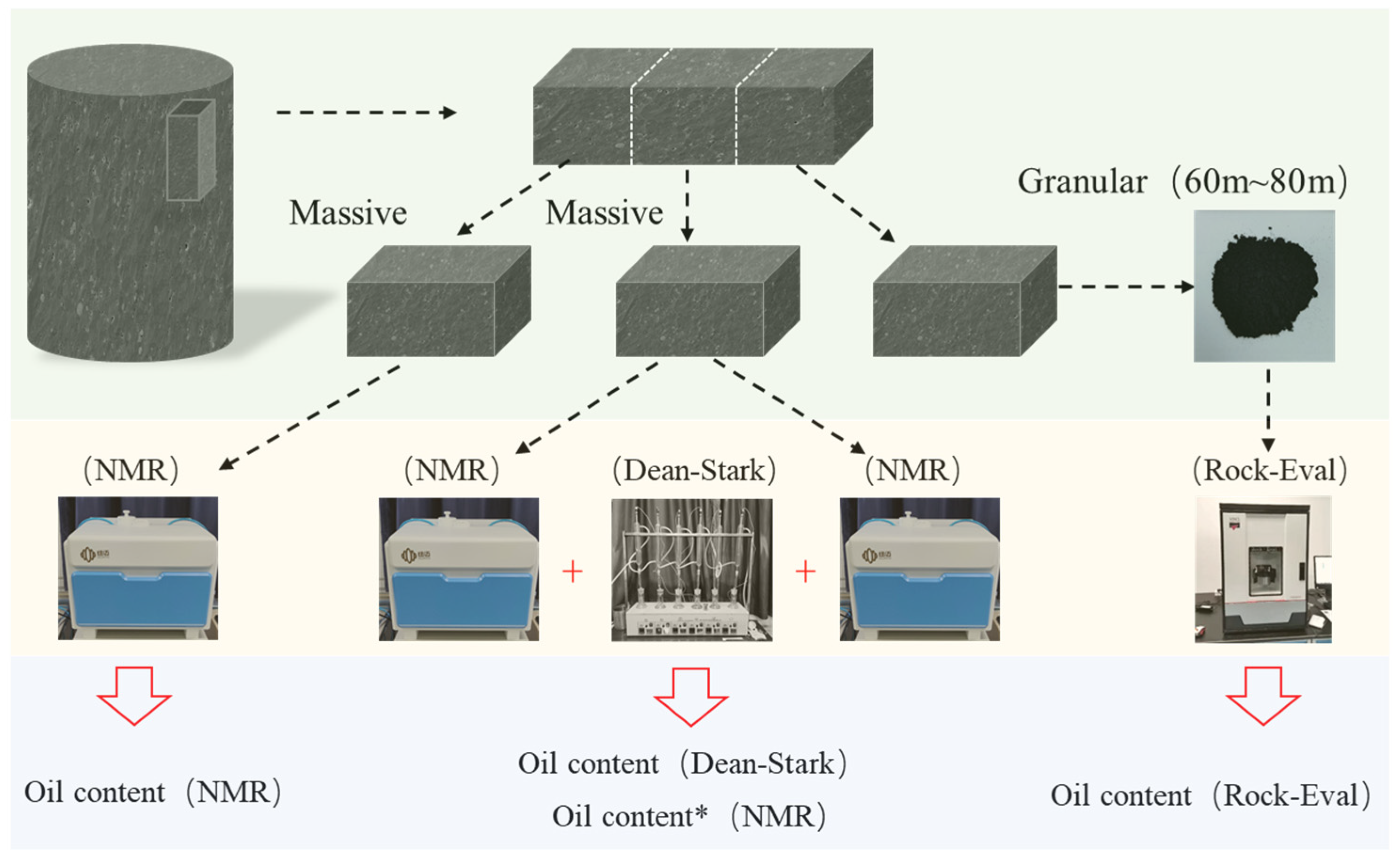

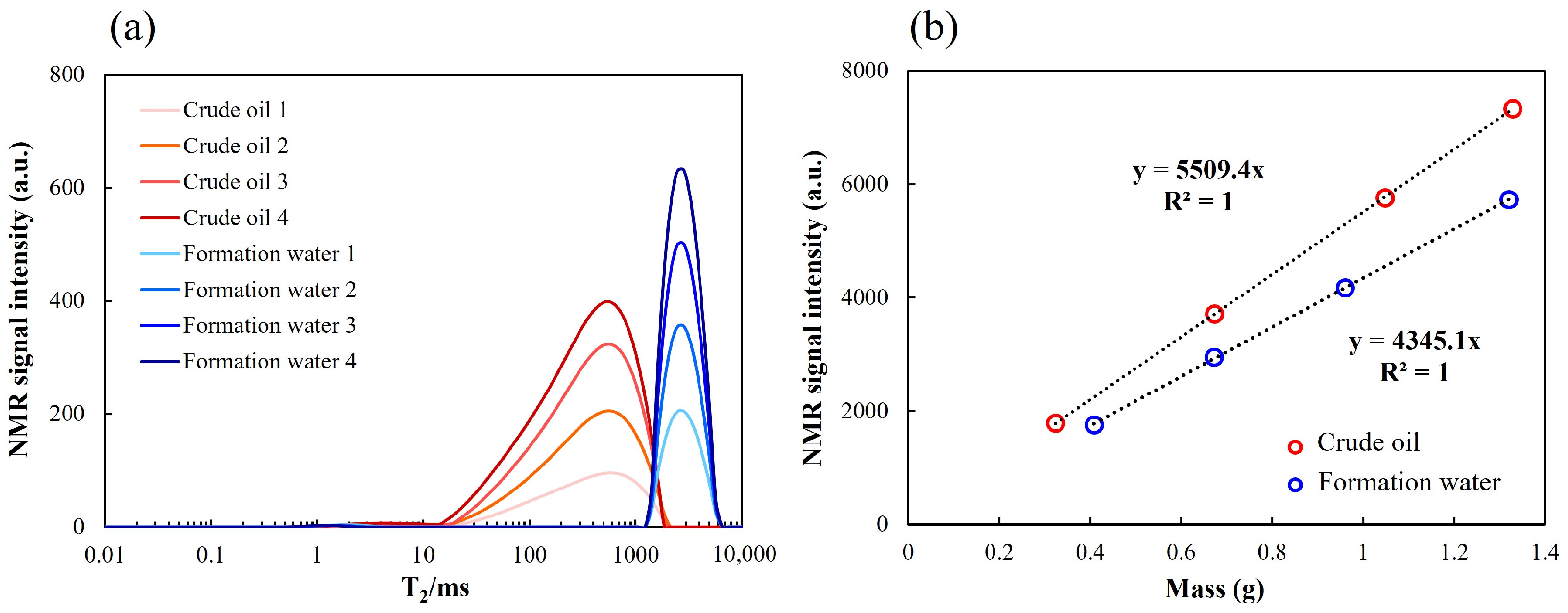
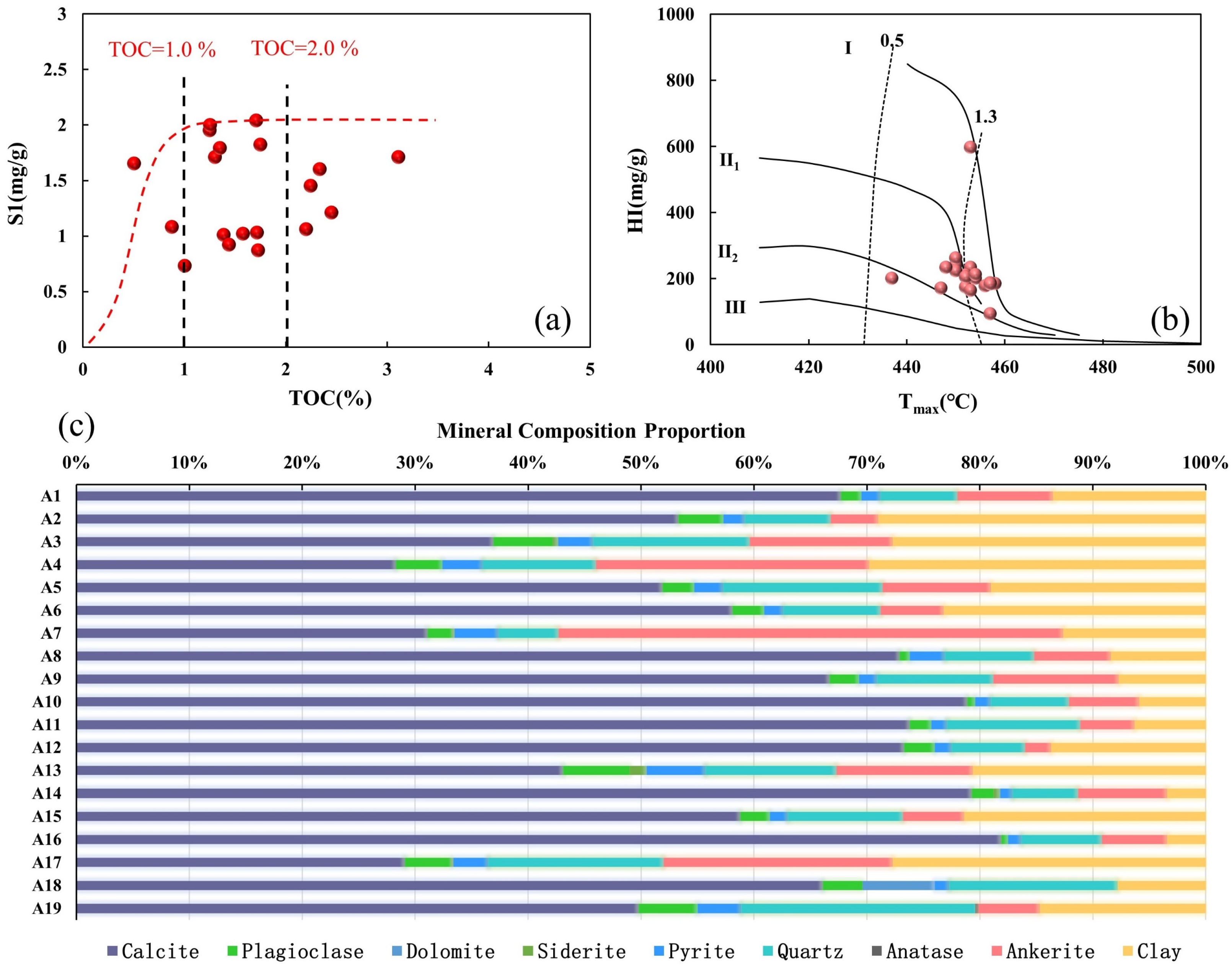
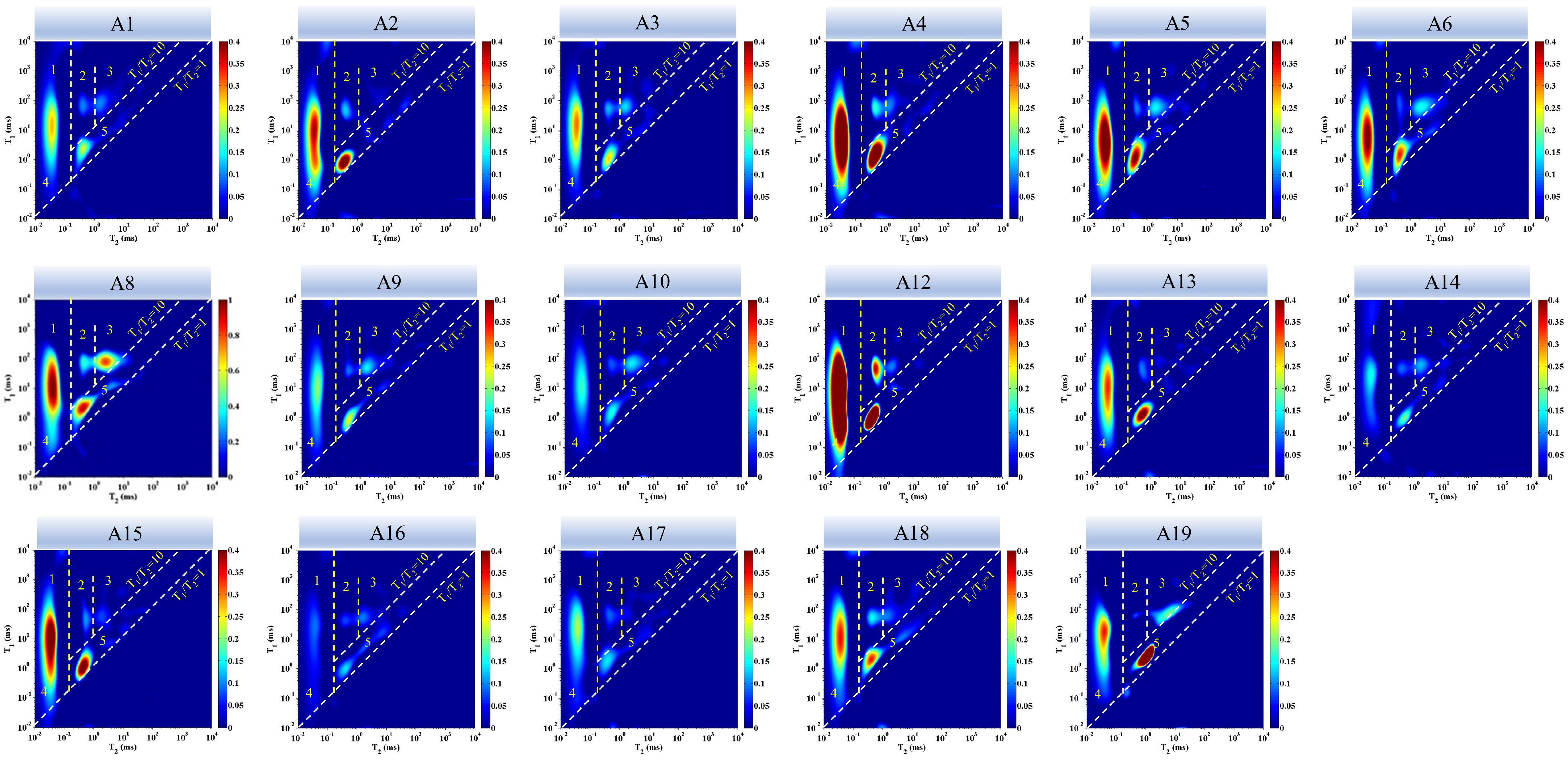
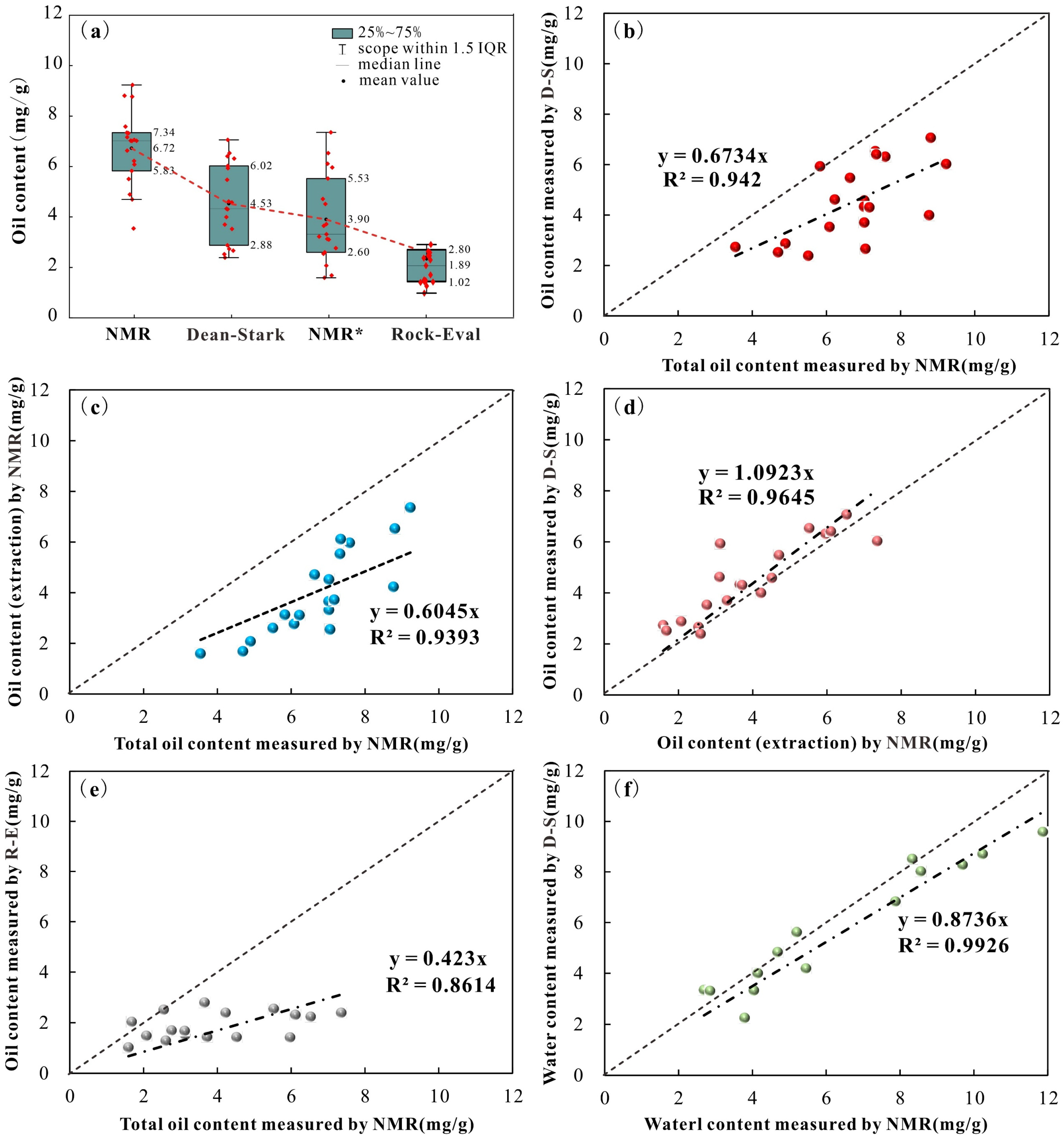
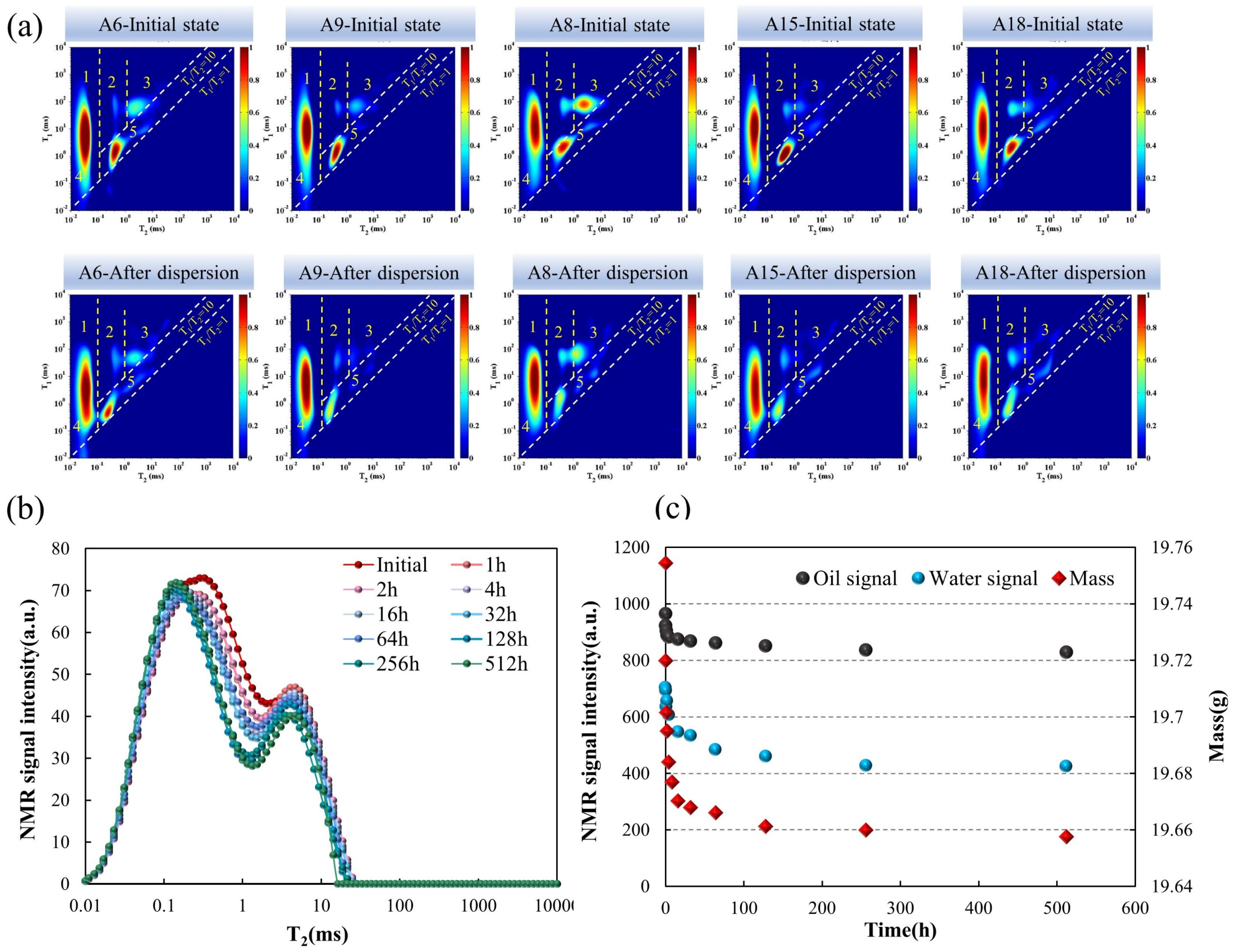

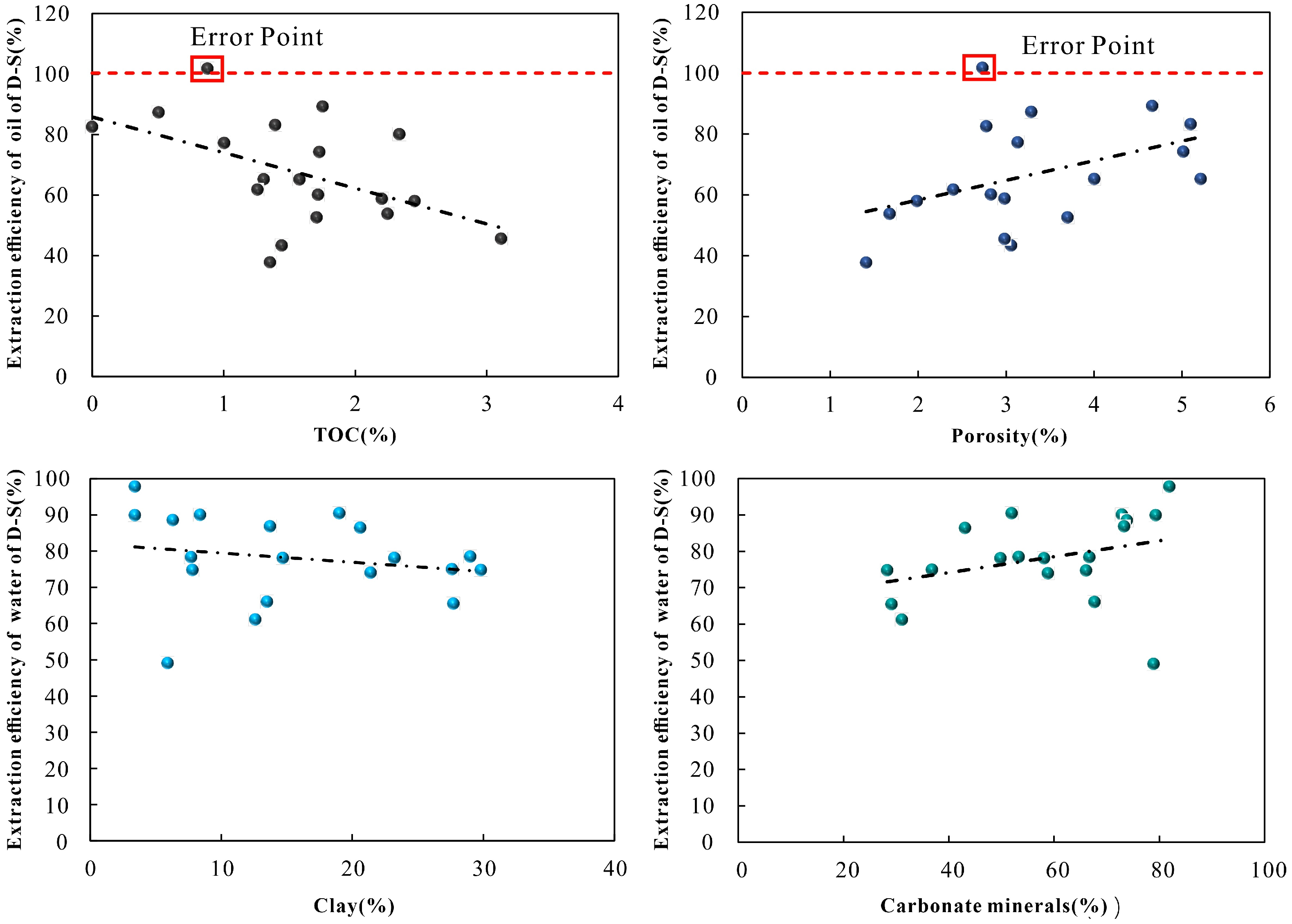
| Sample Number | Depth/m | Dean–Stark | NMR | Rock-Eval | ||||
|---|---|---|---|---|---|---|---|---|
| Oil Content (mg/g) | Water Content (mg/g) | Total Oil Content (mg/g) | Total Water Content (mg/g) | Oil Content* (mg/g) | Water Content* (mg/g) | S1 (mg/g rock) | ||
| A1 | 3525.7 | 5.47 | 4.19 | 6.63 | 6.34 | 4.71 | 5.45 | / |
| A2 | 3529.3 | 2.88 | 8.03 | 4.89 | 10.23 | 2.07 | 8.56 | 1.48 |
| A3 | 3531.4 | 6.53 | 10.17 | 7.32 | 13.56 | 5.53 | 12.46 | 2.54 |
| A4 | 3532.6 | 4.58 | 14.78 | 7.02 | 19.75 | 4.52 | 18.22 | 1.42 |
| A5 | 3534.4 | 6.31 | 11.89 | 7.58 | 13.15 | 5.96 | 12.18 | 1.41 |
| A6 | 3535.5 | 6.02 | 8.27 | 9.23 | 10.59 | 7.35 | 9.69 | 2.39 |
| A7 | 3544.1 | 3.70 | 9.58 | 7.03 | 15.67 | 3.31 | 11.87 | / |
| A8 | 3545.0 | 6.41 | 4.85 | 7.34 | 5.38 | 6.11 | 4.68 | 2.31 |
| A9 | 3548.3 | 4.33 | 4.00 | 7.01 | 5.10 | 3.65 | 4.15 | 2.80 |
| A10 | 3550.8 | 2.66 | 2.26 | 7.06 | 4.60 | 2.54 | 3.79 | 2.50 |
| A11 | 3553.0 | 4.30 | 5.62 | 7.16 | 6.35 | 3.72 | 5.21 | 1.44 |
| A12 | 3592.4 | 7.06 | 21.04 | 8.81 | 24.21 | 6.53 | 23.12 | 2.24 |
| A13 | 3556.0 | 2.74 | 8.52 | 3.54 | 9.86 | 1.59 | 8.33 | 1.02 |
| A14 | 3557.0 | 3.53 | 3.35 | 6.08 | 3.72 | 2.76 | 2.69 | 1.69 |
| A15 | 3557.5 | 2.39 | 8.71 | 5.51 | 11.77 | 2.60 | 10.24 | 1.28 |
| A16 | 3559.5 | 5.93 | 3.31 | 5.83 | 3.38 | 3.13 | 2.86 | 1.51 |
| A17 | 3563.0 | 2.52 | 3.33 | 4.69 | 5.08 | 1.68 | 4.04 | 2.03 |
| A18 | 3570.2 | 4.00 | 6.83 | 8.77 | 9.13 | 3.23 | 7.87 | 2.39 |
| A19 | 3571.3 | 4.62 | 13.93 | 6.22 | 17.82 | 3.11 | 16.86 | 1.68 |
Disclaimer/Publisher’s Note: The statements, opinions and data contained in all publications are solely those of the individual author(s) and contributor(s) and not of MDPI and/or the editor(s). MDPI and/or the editor(s) disclaim responsibility for any injury to people or property resulting from any ideas, methods, instructions or products referred to in the content. |
© 2025 by the authors. Licensee MDPI, Basel, Switzerland. This article is an open access article distributed under the terms and conditions of the Creative Commons Attribution (CC BY) license (https://creativecommons.org/licenses/by/4.0/).
Share and Cite
Wang, M.; Wang, M.; Zhao, X.; Li, J.; Zhang, S.; Tian, M. Comparison of Methods for Determining the Oil Content in Medium-Mature Shale—A Case Study from the Fourth Member of the Shahejie Formation in the Dongying Depression. Energies 2025, 18, 708. https://doi.org/10.3390/en18030708
Wang M, Wang M, Zhao X, Li J, Zhang S, Tian M. Comparison of Methods for Determining the Oil Content in Medium-Mature Shale—A Case Study from the Fourth Member of the Shahejie Formation in the Dongying Depression. Energies. 2025; 18(3):708. https://doi.org/10.3390/en18030708
Chicago/Turabian StyleWang, Min, Min Wang, Xinbin Zhao, Junliang Li, Shun Zhang, and Min Tian. 2025. "Comparison of Methods for Determining the Oil Content in Medium-Mature Shale—A Case Study from the Fourth Member of the Shahejie Formation in the Dongying Depression" Energies 18, no. 3: 708. https://doi.org/10.3390/en18030708
APA StyleWang, M., Wang, M., Zhao, X., Li, J., Zhang, S., & Tian, M. (2025). Comparison of Methods for Determining the Oil Content in Medium-Mature Shale—A Case Study from the Fourth Member of the Shahejie Formation in the Dongying Depression. Energies, 18(3), 708. https://doi.org/10.3390/en18030708






